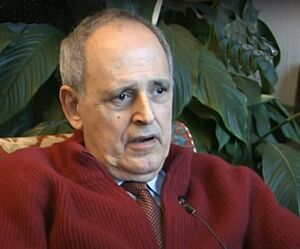Flavio Costantini facts for kids
Flavio Costantini (born September 21, 1926 – died May 20, 2013) was a talented Italian artist. He was known for drawing pictures of writers and artists for newspapers. He also created illustrations for many books. When he first started, his art was inspired by the writer Franz Kafka and by ideas about perfect societies (called utopian ideals) and different ways of organizing society (called anarchist ideals). Later, his art showed a more serious view of the world. He made several series of paintings about historical topics, like the idea of anarchy, the sinking of the Titanic, alchemy (an old form of chemistry), the composer Mozart, the French Revolution and its victims, and the murder of Nicholas II and his family in Yekaterinburg. His very last series of artworks was a deep and sometimes dark look at the story of Pinocchio, which he thought was one of Italy's greatest novels.
Contents
About Flavio Costantini
His Early Life
Flavio Costantini was born in Rome, Italy, in September 1926. His parents were middle-class, and his father enjoyed painting as a hobby. As a child, Flavio was very creative. He kept a diary filled with newspaper clippings, collages, photos, and his own drawings. He went to a famous high school in Rome but had trouble with French and Latin.
During World War II
Flavio Costantini lived through World War II. His experiences during the war made him think a lot about the difficulties and meaning of life. It was also around this time that he became interested in utopianism, which are ideas about creating a perfect society.
He later became a sea captain and worked in the Italian Navy. From 1951 to 1954, he worked in the Merchant Marine, which transports goods by sea. He then moved with his family to Rapallo. In 1959, after visiting Spain, he created a series of paintings about bullfighting.
Flavio was part of a group of artists who started the Galleria del Deposito in Boccadasse, Genoa. Other artists in this group included Eugenio Carmi and Emanuele Luzzati. He loved collecting old illustrated magazines. He used these old pictures and advertisements to create his paintings and portraits in his home and studio in Rapallo. His art often showed scenes from Genoa, like squares, shops, and boats, mixing old and new styles.
The poet Philip Levine wrote a poem called "On a Drawing by Flavio." It describes Costantini's powerful drawing of the Rabbi of Auschwitz, who "bows his head and prays / for us all." Flavio Costantini passed away in Genoa in May 2013 after a short illness. A memorial meeting was held for him at the Museo Luzzati in Genoa, which now has many of his artworks.
How He Got Started in Art
Flavio first tried illustration after his time in the Italian navy. He started by drawing pictures inspired by the writer Kafka. He once said, "I started to draw because I read the Kafka books… it was impossible to write like Kafka, so I began to draw." Other writers later inspired him, but Kafka's way of showing the human experience remained a big influence.
However, it wasn't until the 1960s that he read Memoirs of a Revolutionary by Victor Serge. This book inspired him to support anarchism through his art. Anarchism is a political idea that suggests society could work without a government, relying instead on voluntary cooperation.
His Artworks
Flavio Costantini's art often showed important people and events from anarchist history. He painted figures like Ravachol, Nestor Mahkno, Errico Malatesta, and Mikhail Bakunin. He also depicted groups like the Industrial Workers of the World and the Bonnot gang, and events like the assassination of Archduke Ferdinand. His art helped tell the stories of those who wanted big changes in society.
His artworks were put together in a book called The Art of Anarchy. It was first published in 1975 and then again in 1986.
Books He Illustrated
Flavio Costantini illustrated several novels, bringing their stories to life with his drawings:
- The Pony by Vladimir Mayakovsky (1969, reprinted 2006)
- Heart by Edmondo De Amicis (1977)
- The Shadow Line by Joseph Conrad (1989)
- Notes from Underground by Fyodor Dostoyevsky (1997)
See also
- Anarchist art


